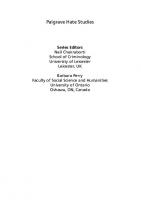Xenophobia: The Violence of Fear and Hate 1435852796, 9781435852792
Xenophobia—the fear and hatred of foreigners—has been making headlines at an alarming rate as immigration soars worldwid
310 14 4MB
English Pages [72] Year 2009
Recommend Papers

- Author / Uploaded
- Jamie Bordeau
File loading please wait...
Citation preview
MACEWAN LIBRARY
100603503:
aoi£
THE VIOLENCE OF FEAR AND HATE Jamie Bordeau
ROSEN PUBLISHING* New York
LIBRARY GRANT MacEWAN UNIVERSITY
Published in 2010 by The Rosen Publishing Group, Inc. 29 East 21st Street, New York, NY 10010 Copyright © 2010 by The Rosen Publishing Group, Inc. First Edition All rights reserved. No part of this book may be reproduced in any form without permission in writing from the publisher, except by a reviewer. Library of Congress Cataloging-in-Publication Data Bordeau, Jamie. Xenophobia: the violence of fear and hate / Jamie Bordeau. p. cm. —(In the news) Includes bibliographical references and index. ISBN-13: 978-1-4358-5279-2 (library binding) ISBN-13: 978-1-4358-5564-9 (pbk) ISBN-13: 978-1-4358-5565-6 (6 pack) 1. Xenophobia. 2. Minorities —Crimes against. 3. Racism. 4. Immigrants — Crimes against. I.Title. HV6250.4.E75B67 2010 305.8 —dc22 2008050791 Manufactured in the United States of America On the cover:Top right: Protesters in South Africa march against xeno¬ phobia after a series of riots in and around Johannesburg killed sixty people in May 2008.Top left: Asian residents flee as xenophobic violence between Asian and white youths engulfs the town of Oldham, England, in May 2001. Bottom: Immigration supporters clash with members of the anti-illegal immigration Minutemen organization during a rally in New York City in July 2006.
contents
1 2 3 4 5
What Is Xenophobia?
4
Xenophobia in the United States
14
Xenophobia in Europe
30
Xenophobia in South Africa
43
Combating Xenophobia
49
Glossary
54
For More Information
55
For Further Reading
57
Bibliography
58
Index
62
What Is Xenophobia?
T
he word "xenophobia" comes to us from the Greek language. "Xeno" comes from the Greek word xenos, which means foreigner or stranger,
and "phobia" comes from the word phobos, which means fear. When you put both words together, you get the proper definition of xenophobia: an irrational fear or distrust of foreigners. It is important not to confuse xenophobia with racism. Racism is the belief that one race is superior to another, while xenophobia is the hatred of foreigners based on fear. While racism and xenophobia sometimes go hand in hand, it is possible for people of the same race to be xenophobic toward one another. As the United Nations Educational, Scientific and Cultural Organization (UNESCO) explains on its Web site, racism is prejudice based on differences in physical characteristics, such as skin color, hair type, and facial features. Xenophobia is prejudice based on the belief
What Is Xenophobia?
Immigrant Population as a Percentage of the Total Population
More than 50% 20% to 50%
10% to 20%
4% to 10%
1 % to 4%
Less than 1%
No Data
This map displays the countries of the world shaded according to the proportion of immigrants within their populations. The United States has the most immigrants, with more than thirty-eight million. Immigrants make up almost 13 percent of the total U.S. population.
that certain people are outsiders and are foreign to the community or nation. Xenophobia has been making headlines at an alarming rate, as many countries in the world experience rapid change.The population makeup and cultural identities of countries on every continent are shifting as a result of globalization and mass immigration. As these shifts are taking place, acts of xenophobic violence have been occurring all across the globe, most notably in the United States, Europe, and South Africa.
Xenophobia: The Violence of Fear and Hate
Causes of Xenophobia There are a number of different factors that breed xeno¬ phobic attitudes and acts of xenophobic violence. These factors include economic distress, increased nationalism and nativism, and pressures related to immigration. In recent years, xenophobia has also grown because of global terrorism and other security threats. In a number of countries, citizens' fears about security have led to negative attitudes toward newcomers and foreigners.
Economic Strife In times of economic strife, citizens often look for a scapegoat, or someone to blame, for their poor financial situation. When unemployment rates begin to rise, it is common for xenophobia to rise as well. Since immigrants sometimes compete with longer-term citizens for jobs, and since they are often willing to work for lower wages, they are often seen as a threat to job security. Sylvanus Dixon, a community organizer from Sierra Leone, spoke to the BBC about the causes of xenophobia in his adopted homeland of South Africa. He claimed that jealousy and fear related to employment and income were to blame. "[South Africans] see foreigners with businesses and they don't know how they got their money," Dixon said. "That's where the jealousy is coming from.That's when the fear becomes xenophobia."
What Is Xenophobia?
Nationalism and Nativism Anti-immigrant sentiment sometimes leads to the rise of nationalistic political parties and nativist groups. Nationalists are people who feel a strong loyalty to their country and its traditions. In fact, nationalists may pledge loyalty to country above all else and may view their country and its traditions as more important than any other. Xenophobia and nationalism can go hand in hand, as many nationalists feel that immigrants are a threat to their countries' cultural identities. Nativists believe that native-born citizens should be afforded more rights and protections than foreign-born citizens. Nationalism and nativism often contribute to a culture of xenophobic thinking. As immigration soars worldwide, many countries are dealing with an influx of people who speak different languages and who hold different cultural traditions and beliefs. It is common for people to be afraid of the unknown. In times of rapid change and uncertainty, many citizens resort to xenophobic views to help them justify their fears.
Xenophobia in American History The connection between economic strife, nationalism, and xenophobia has been in place for decades. One
Xenophobia: The Violence of Fear and Hate
example of this connection can be seen in the struggles of Chinese immigrants in the United States during the late 1800s. After the South seceded from the Union dur¬ ing the Civil War, President Abraham Lincoln passed the Pacific Railway Act of 1862 in an attempt to connect California with the rest of the Union via a transcontinental railroad.The Central Pacific Railroad Company, faced with a shortage of workers, hired Chinese immigrants to aid in the completion of the first transcontinental railroad. The work was grueling and did not pay well, but it is estimated that more than twelve thousand Chinese immigrants contributed to the project, working tirelessly to complete their sections of the railroad. By the 1870s, however, times were tough for American workers. Chinese immigrants, who had been considered a steady source of cheap labor, were blamed for rising unemployment. Nationalist groups sprang up to protest the influx of Chinese immigrant workers. Dennis Kearney founded the California Workingmen's Party in 1874 to push a xenophobic agenda that blamed the Chinese immigrants for the problems of working Americans. Driven by the anti-immigrant sentiment of such nationalist groups, the U.S. government passed the Chinese Exclusion Act of 1882.This strict anti-immigration law barred any Chinese miners or laborers, skilled or unskilled, from entering the country for ten years.Those who broke the law were deported or imprisoned.
What Is Xenophobia?
(foiigrss of tMinitri) Statrs. ^ z
■ *

![Hate Speech in Asia and Europe: Beyond Hate and Fear [1 ed.]
9780429563508](https://ebin.pub/img/200x200/hate-speech-in-asia-and-europe-beyond-hate-and-fear-1nbsped-9780429563508.jpg)
![Hate Speech in Asia and Europe: Beyond Hate and Fear [1 ed.]
9780367209001, 9780429264009](https://ebin.pub/img/200x200/hate-speech-in-asia-and-europe-beyond-hate-and-fear-1nbsped-9780367209001-9780429264009.jpg)






